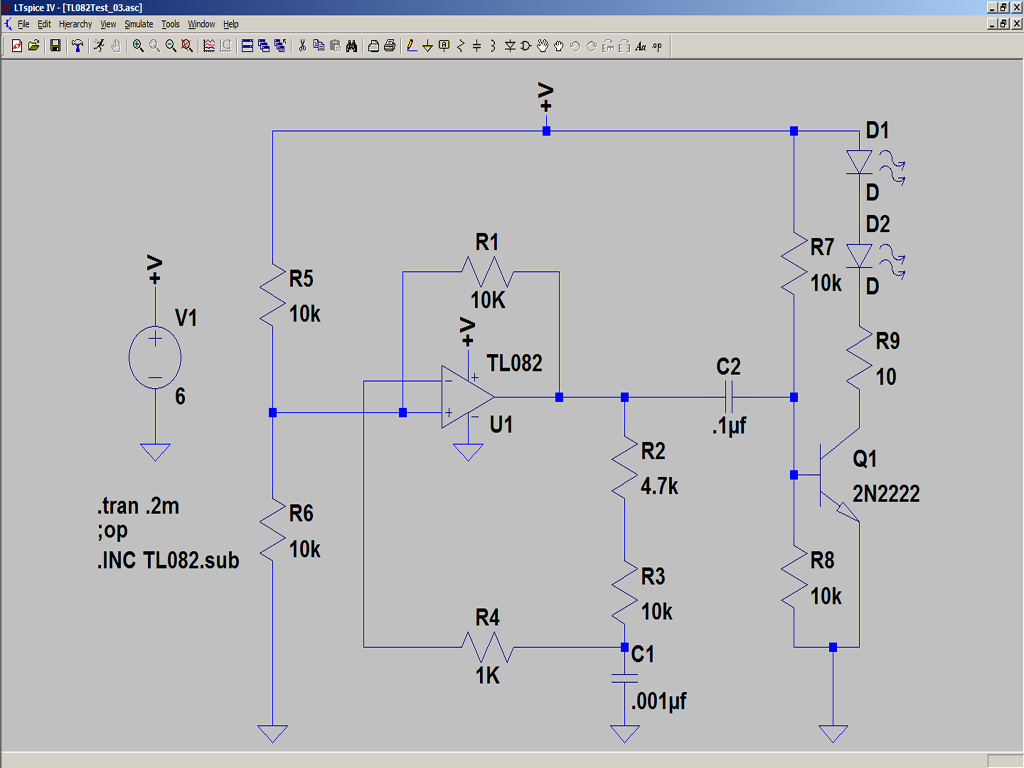
More DIY IR Jammer

A DIY infrared (IR) jammer was tested on a breadboard last weekend, and the results are being shared. The schematic was accurately recreated on the plugboard, with a small bench power supply set to 6 volts to simulate four AA batteries. When powered, the circuit oscillated as expected; however, the oscillation frequency did not match the predictions from LT Spice. Initially, an arbitrary operational amplifier (Op Amp) from Linear Technology was selected, which led to the discrepancy. A TL082 model was later found, yielding results nearly identical to the actual circuit. A screenshot of the LT Spice schematic, including the spice directives for the external model, is provided. The lesson learned is the importance of using the correct model for accurate results. The TL082 model is included for those interested in conducting their simulations. Two simple tests confirmed the circuit's emission of infrared pulses: the first involved pointing a video camera at the LEDs while the circuit was active, and the second used a photodiode connected to an oscilloscope aimed at the IR LEDs to observe the resultant pulses. The setup was conducted in a living room, where the lab supply and plugboard were placed on a coffee table. Although the setup was not discreet, it successfully disabled the remote control's ability to change channels.
A DIY infrared jammer circuit can be designed using a TL082 operational amplifier, which is a low-noise JFET-input op-amp suitable for audio and low-frequency applications. The circuit typically consists of a feedback loop that generates oscillations at a frequency that interferes with IR remote signals. The TL082's characteristics allow for stable oscillation and precise control over the output frequency.
The circuit schematic would include the TL082 configured in an astable multivibrator arrangement, where the timing components, typically resistors and capacitors, determine the oscillation frequency. The output from the op-amp would drive a series of infrared light-emitting diodes (LEDs), which emit IR pulses that can disrupt the communication between a remote control and its target device.
The power supply, set to 6 volts, is connected to the circuit to ensure that the op-amp and IR LEDs operate efficiently. The use of a breadboard facilitates easy adjustments and modifications to the circuit, allowing for experimentation with component values to achieve the desired output frequency.
Testing the circuit involves using a video camera or a photodiode connected to an oscilloscope to verify that the IR LEDs are emitting pulses. The photodiode's output can be observed on the oscilloscope, displaying the pulse train generated by the circuit. This method provides a visual confirmation of the circuit's functionality.
In practical applications, the IR jammer can be used to block signals from remote controls, effectively disabling their functionality. However, caution should be exercised, as the use of jammers may be subject to legal restrictions depending on the jurisdiction.Breadboard and test the DIY IR jammer last weekend but it`s taken me this long to carve out a minute to post the results. The schematic is correct and only took a few minutes to re-create on the plugboard. For power I used a small bench supply set to 6 volts to duplicate four AA cells. When I powered up the circuit it oscillated just as pred icted, but the frequency of oscillation did not agree with LT Spice. The first time I entered in the schematic I just picked an arbitrary Op Amp from those provided by Linear Technology. That is what caused the discrepancy. I tracked down a TL082 model and that provided results that are nearly identical to the actual circuit.
Here is a screen shot of the LT Spice schematic including the spice directives used to add the external model. So the lesson here is use the correct model for accurate results. I`m including the TL082 model I used in the body of the post. Just copy and paste it into a text file adding a. sub extension if you want to do your own simulation. I came up with two simple tests to confirm that the circuit was actually emitting infrared pulses. The first test was to simply point a video camera at the LEDs while the circuit was on. This picture shows this basic setup. The next test was equally as easy and simply involved attaching a photodiode to an oscilloscope, and then pointing that photodiode at the IR LEDs.
The resultant pulses can be easily seen here. I took the lab supply with the plugboard on top into the living room and set it on the coffee table and flipped the power supply switch on. Admittedly my setup is not very covert, but it did successfully disable the remote`s ability to change channels.
🔗 External reference
A DIY infrared jammer circuit can be designed using a TL082 operational amplifier, which is a low-noise JFET-input op-amp suitable for audio and low-frequency applications. The circuit typically consists of a feedback loop that generates oscillations at a frequency that interferes with IR remote signals. The TL082's characteristics allow for stable oscillation and precise control over the output frequency.
The circuit schematic would include the TL082 configured in an astable multivibrator arrangement, where the timing components, typically resistors and capacitors, determine the oscillation frequency. The output from the op-amp would drive a series of infrared light-emitting diodes (LEDs), which emit IR pulses that can disrupt the communication between a remote control and its target device.
The power supply, set to 6 volts, is connected to the circuit to ensure that the op-amp and IR LEDs operate efficiently. The use of a breadboard facilitates easy adjustments and modifications to the circuit, allowing for experimentation with component values to achieve the desired output frequency.
Testing the circuit involves using a video camera or a photodiode connected to an oscilloscope to verify that the IR LEDs are emitting pulses. The photodiode's output can be observed on the oscilloscope, displaying the pulse train generated by the circuit. This method provides a visual confirmation of the circuit's functionality.
In practical applications, the IR jammer can be used to block signals from remote controls, effectively disabling their functionality. However, caution should be exercised, as the use of jammers may be subject to legal restrictions depending on the jurisdiction.Breadboard and test the DIY IR jammer last weekend but it`s taken me this long to carve out a minute to post the results. The schematic is correct and only took a few minutes to re-create on the plugboard. For power I used a small bench supply set to 6 volts to duplicate four AA cells. When I powered up the circuit it oscillated just as pred icted, but the frequency of oscillation did not agree with LT Spice. The first time I entered in the schematic I just picked an arbitrary Op Amp from those provided by Linear Technology. That is what caused the discrepancy. I tracked down a TL082 model and that provided results that are nearly identical to the actual circuit.
Here is a screen shot of the LT Spice schematic including the spice directives used to add the external model. So the lesson here is use the correct model for accurate results. I`m including the TL082 model I used in the body of the post. Just copy and paste it into a text file adding a. sub extension if you want to do your own simulation. I came up with two simple tests to confirm that the circuit was actually emitting infrared pulses. The first test was to simply point a video camera at the LEDs while the circuit was on. This picture shows this basic setup. The next test was equally as easy and simply involved attaching a photodiode to an oscilloscope, and then pointing that photodiode at the IR LEDs.
The resultant pulses can be easily seen here. I took the lab supply with the plugboard on top into the living room and set it on the coffee table and flipped the power supply switch on. Admittedly my setup is not very covert, but it did successfully disable the remote`s ability to change channels.
🔗 External reference





